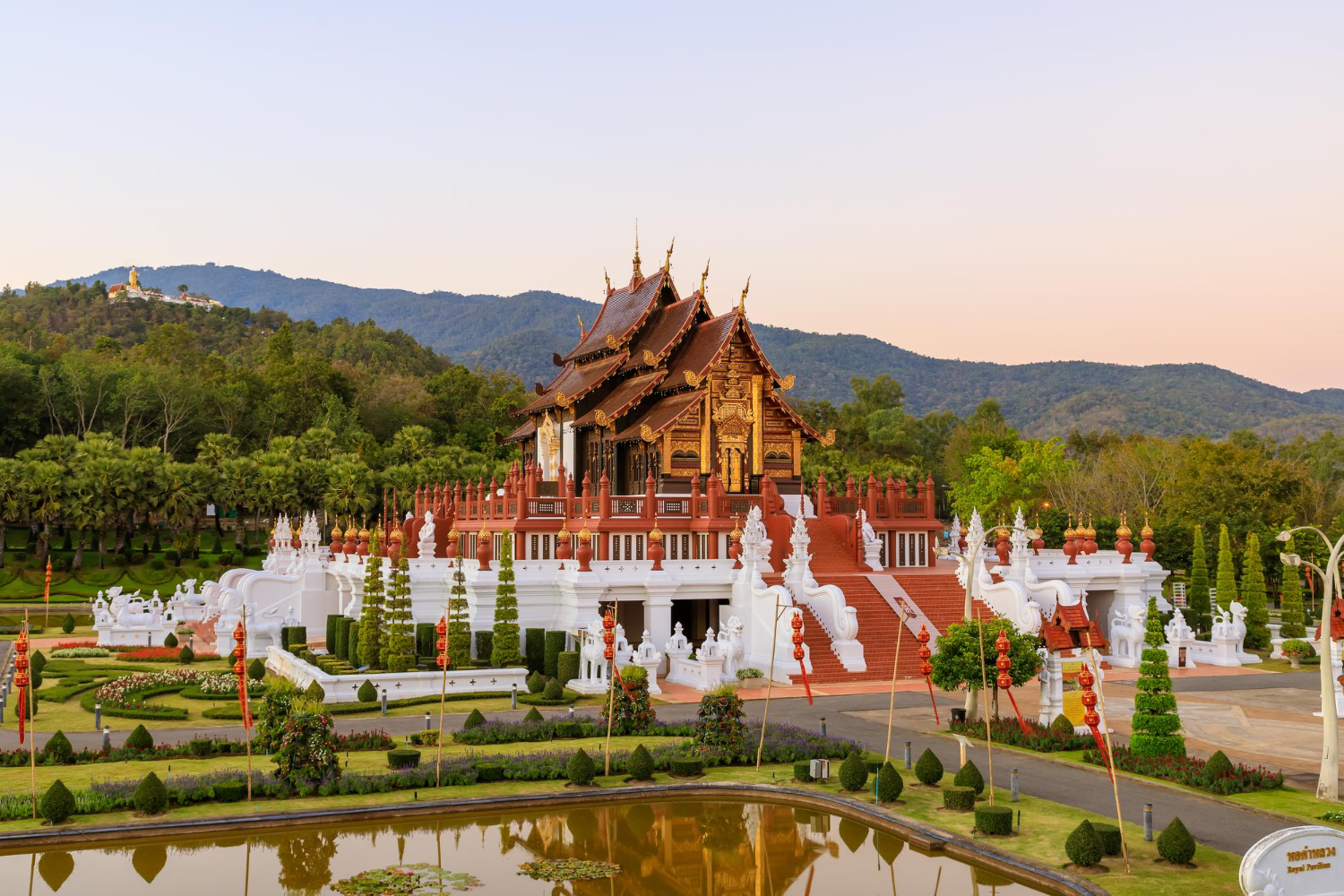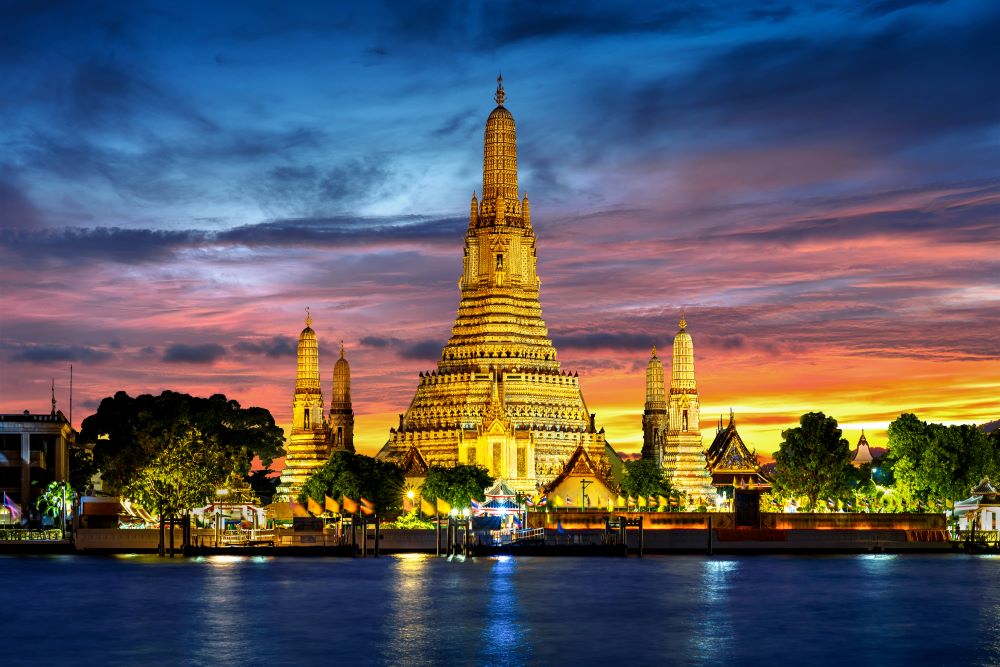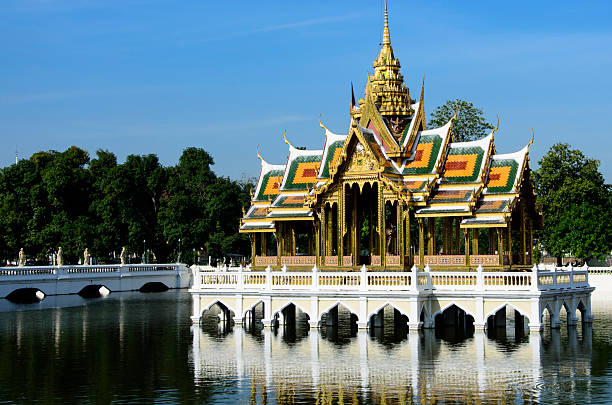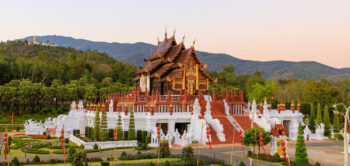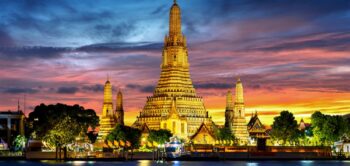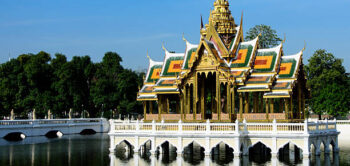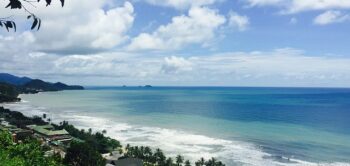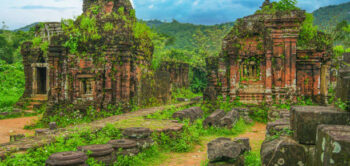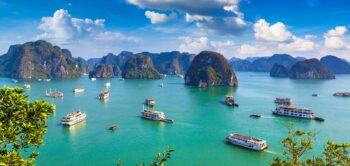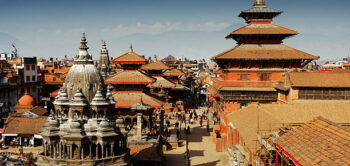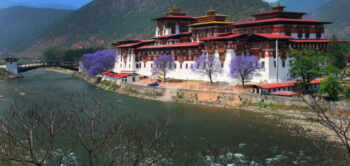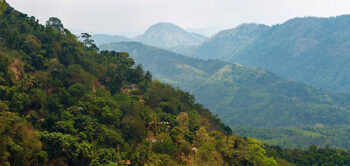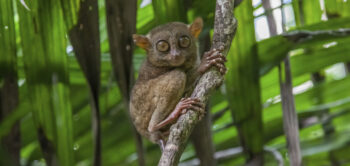From Bangkok to Beaches: A 14 Day Holiday to Thailand
Tour Detail
Highlights of the Trip
Jet off on a 14-day trip of a lifetime through Thailand, a journey that seamlessly blends history, culture, natural beauty, with the perfect beach holiday in Thailand.
Begin your odyssey in Bangkok, where you’ll explore iconic sites like the Grand Royal Palace and the sacred Wat Phra Kaew, and cruise down the Chao Phraya River to the enchanting Wat Arun.
Heading southwest, you’ll visit the bustling Maeklong Railway Market and vibrant floating markets, before paying respects at Kanchanaburi’s World War Two memorial and taking a dip in Erawan Waterfall’s serene natural pools. Ayutthaya’s ancient temples and the impressive Bang Pa-In Summer Palace beckon before you fly to Chiang Rai. Chiang Rai offers local markets, ornate temples, and a glimpse into traditional Thai life. Venture into the northern highlands, exploring tea plantations, engaging with Akha, Loyo, and Lisu villagers, and visiting the Mae Fah Luang Botanical Garden and the fabled Golden Triangle.
In Chiang Sean, connect with the Padong Karen Tribe and delve into traditional Chinese medicine. Chiang Mai welcomes you with underground galleries, ancient temples, and bustling markets. Rickshaw tours, Doi Suthep Hill, and an Elephant Poopoo Paper Farm visit add an exciting twist to your adventure. Your journey continues with a scenic boat trip along the Mae Ping River and an overnight train to Bangkok. From there, fly to Trat Airport for the tropical paradise of Koh Chang Island. Leisurely beach days allow you to unwind.
This itinerary offers a kaleidoscope of experiences, blending history, culture, local life, scenic beauty, and relaxation. It’s a perfect choice for those seeking an authentic immersion into Thailand’s wonders, where every day promises new discoveries and lasting memories.
Destinations and the Landmarks / Sights to Visit
Bangkok
- Grand Palace: Originally built in 1782, the Grand Palace was the official residence of the Thai royal family for over 150 years.
- Wat Phra Kaew: One of the most well-known and revered temples in Thailand.
- Wat Pho: The Temple of the Reclining Buddha with a history that dates back over 200 years.
- Wat Arun: The temple has a long and rich history, dating back to the Ayutthaya period in the 17th century.
- World War II Memorial (Kanchanaburi): A powerful and emotional reminder of the sacrifices made during the Second World War.
- Jeath War Museum and Cemetery: This comprehensive museum and cemetery provides information on the sacrifices made during the construction of the Burma Railway, also known as the ‘Death Railway’.
Ayutthaya
- Wat Yai Chaimongkol: This temple was built in the 14th century by King U Thong, the first king of the Ayutthaya Kingdom.
- Wat Mahathat: A magnificent Buddhist temple complex with a rich history and cultural significance, built in the 14th century.
- Bang Pa-In Summer Palace: The palace was built in the 17th century as a retreat for the Thai kings and has been used as a summer residence for the royal family ever since.
Chiang Rai
- Wat Phra Kaew and Wat Phra Singh: Two of the most striking and revered temples in Thailand.
- Mae Fah Luang Botanical Garden: This magnificent garden was established in 1993 by the Royal Patronage of Princess Srinagarindra.
Chiang Mai
- Wat Phra Singh Temple: One of the most revered and iconic Buddhist temples in Chiang Mai.
- Wat Phan Tao Temple: Renowned for its beautiful architecture, intricate wood carvings and serene atmosphere.
- Wat Chedi Luang Temple: A magnificent temple that boasts a rich history and breath-taking architecture.
- Elephant Poopoo Paper Farm: Here you can collect the dung from elephants and produce high-quality paper products!
Koh Chang Island
- Unwind and relax at this serene destination and experience an idyllic beach holiday in Thailand.
Cultural Experiences & Activities of this Holiday
Maeklong Railway Market: A unique and bustling market located just an hour outside of Bangkok, Thailand. What makes this market so special is that it is set up on the railway track of the Maeklong Railway. This means that several times a day, when the train comes through, the vendors must quickly pack up their goods and retract their awnings as the train passes through.
Local Rural Villages: Embrace local life and tradition with visits to the village of Akah of Loyo and the Village Lisu of Ban Hanygo during your holiday in Thailand.
Padong Karen tribe in Patai: The Padong Karen tribe is a fascinating community that can be found in the Patai region of Thailand. They are known for their traditional way of life and their distinctive appearance, with the women of the tribe famous for their long, brass-coiled necks. This practice of wearing brass coils around their necks has become a significant cultural symbol of the tribe and has attracted tourists from all over the world to visit and learn about their customs.
Local Cuisine and Traditional Dishes to try while in Thailand
During your holiday to Thailand, numerous opportunities will arise for you to savour the authentic local cuisine, whether from the menus of included meals or from your own culinary exploration during your free time in the itinerary. Indulge in traditional dishes that showcase the rich flavours of the region, including the famous Pad Thai, a stir-fried noodle dish that is a quintessential part of the country’s street food culture. Another popular street food dish is the Som Tam, a refreshing and spicy green papaya salad that combines the flavours of sour, sweet, and spicy. For a more indulgent experience, one should not miss out on the delicious Tom Yum soup. This hot and sour soup is made with a variety of aromatic herbs, spices, and seafood (shrimp or fish) and is a favourite among locals and tourists alike.
Water-based Activities and Cruises
- Long-tail boat along the Chao Phraya River and inner canals of Thonburi.
- Motorboat trip along the waterway to the rural floating market of Damnoen Saduak.
- Erawan Waterfall in Erawan National Park.
- Boat trip along the Mekong River to see the Thailand, Burma & Laos triangle.
- Two-hour scenic boat trip along the Mae Ping River.
Accommodation of this Tour
Bangkok: Residence Hotel Silom 3* Deluxe.
Kanchanaburi: Royal River Kwai Resort 3* Superior.
Ayutthaya: Classic Kameo Hotel 3* Deluxe.
Chiang Rai: Laluna Hotel & Resort 3* Garden Bungalow.
Chiang Saen: Siam Triange hotel 3* Deluxe River.
Chiang Mai: White Boutique hotel 3* Deluxe.
Koh Chang: Kong Prao Resort 3* Superior.
Itinerary
Day 1: Bangkok Arrival
Arrive at Suvanabhumi airport, Bangkok. Your guide and driver will welcome you. Transfer to your hotel to check in. Enjoy rest of day at leisure. Stay overnight in Bangkok.
Day 2: Bangkok City Tour
Enjoy breakfast at hotel. Visit the Grand Royal Palace and Wat Phra Kaew and see statue of Emerald Buddha. Continue to Wat Pho (house of the reclining Buddha). Stop for lunch at a restaurant. Walk in Chinatown. Visit Wat Traimit (Golden Buddha).
In the afternoon board a long-tail boat along the Chao Phraya River and inner canals of Thonburi. Visit to Wat Arun, The Temple of Dawn, along the way. Return to hotel in Bangkok for free time. Stay overnight in Bangkok.
✓ Breakfast, Lunch
Day 3: Further Bangkok Exploration & Kanchanaburi Tour
Morning drive to southwest of Bangkok. Visit the Maeklong railway market. Continue drive to Damnoen Saduak. Take a motorboat trip along the waterway to the rural floating market of Damnoen Saduak. Try a paddle boat ride along the canals and stroll around the market when off the boat. (Optional) If visiting on a Saturday or Sunday, you have the option to visit Damnoen Saduak or take a short paddle boat tour to the the smaller, less touristy Tha Kha floating market, where you can visit an old Thai ho Duse making coconut palm sugar.
Travel to Kanchanaburi and visit the World War II memorial and Jeath war Museum and Cemetery. Then board the train from Wang Pho for a scenic 30-minute ride. Transfer by car to your hotel in Kanchanaburi for check in and overnight stay.
✓ Breakfast, Lunch
Day 4: Erawan National Park & Ayutthaya Transfer
Enjoy breakfast. Travel to Erawan Waterfall in Erawan National Park. (Pack good walking shoes and a swimsuit to swim in the fall’s natural pools!)
In the afternoon, drive to Ayutthaya (“The Venice of the East”). Check in and overnight stay at accommodation in Ayutthaya.
✓ Breakfast, Lunch
Day 5: Ayutthaya Tour, Bangkok Transfer & Chiang Rai Flight
Have breakfast. Catch a Kermit tuk tuk for a ride through the city, exploring the temple highlights including Wat Yai Chaimongkol and Wat Mahathat. Walk through the local market en route to Wat Phra Srisanphet and visit the Bang Pa-In Summer Palace.
Transfer back to Bangkok. Flight to Chiang Rai. Pick up and transfer to your hotel. Rest of day at leisure. Stay overnight in Chiang Rai.
✓ Breakfast
Day 6: Chiang Rai Tour
Visit the local market of Chiang Rai and the famous Wat Phra Kaew and Wat Phra Singh. Take a short drive from Chiang Rai City to Baan Dam (Black House). Enjoy rest of day at leisure and stay overnight in Chiang Rai.
✓ Breakfast
Day 7: Mae Salong, Tea Plantations Tour, Rural Villages, Golden Triangle Boat Trip & Chang Sean Transfer
After breakfast, travel to the mountainous woodland area of northern Thailand. Visit Mae Salong, explore and climb the hills of tea plantations.
Visit two local rural villages; the village of Akah of Loyo and the Village Lisu of Ban Hanygo. Then visit the Mae Fah Luang botanical garden. Continue to Golden Triangle and take boat trip along the Mekong River to see the Thailand, Burma & Laos triangle. Stay overnight in Chiang Sean.
✓ Breakfast, Lunch
Day 8: Thaton Transfer, Padong Karen Tribe Village & Chiang Mai Transfer
Enjoy breakfast. Travel to Thaton. Stop en route to visit the village of Patai to meet the Padong Karen tribe, famous for their long necks. Visit a traditional Chinese medicine pharmacy to learn from an expert about the medicinal use of roots, herbs, plants, and ointments.
In the afternoon, drive to Chiang Mai, the Northern capital. Stop for a walk through the underground galleries in Chiang Dao. Continue to Chiang Mai for check-in and overnight stay.
✓ Breakfast, Lunch
Day 9: Chiang Mai Tour
Take a walking tour of the old town of Chiang Mai, stopping at sights of interest and visiting many temples, including Wat Phra Singh temple, Wat Pan Tao temple, and Wat Chedi Luang temple. Walk through the traditional houses and take a rickshaw tour.
Then enjoy a walking tour through the central market of Warorot and Doi Suthep Hill. In the evening, you have the option to explore the Night Market by yourself. Stay overnight in Chiang Mai.
✓ Breakfast, Lunch
Day 10: Elephant Poopoo Paper Farm, Mae Ping River Boat Tour & Bangkok Sleeper Train
Enjoy breakfast. Transfer to the eco-friendly outdoor museum park, Elephant Poopoo Paper Farm. Learn about the stages involved in producing paper products from elephant poop fibres and even practice making your own poopoo paper from elephant poop!
In the afternoon, hop aboard a two-hour scenic boat trip along the Mae Ping River. Then board the overnight train in a second-class cabin for Bangkok (without a guide). Spend the night on board the train.
✓ Breakfast, Lunch
Day 11: Koh Chang Island Transfer & Beach Time
Arrive in Bangkok – approx. 7-8am. Meet your driver for transfer to Bangkok airport. Flight from Bangkok airport to Trat airport. On arrival, your driver will meet you. Transfer to pier to catch the ferry to Koh Chang Island for your serene beach holiday in Thailand. Enjoy the rest of the day at leisure making the most of the beach. Stay overnight in Koh Chang.
✓ Breakfast
Days 12-13: Koh Chang island Free Time
Enjoy these two days free to do as you wish! Explore the area, relax on the beach, or find some activities that interest you.
✓ Breakfast
Day 14: Bangkok Transfer & Departure Flight
Enjoy most of today at your own leisure. Later, transfer back to Trat airport for flight to Bangkok. Arrive in Bangkok in good time to connect to your international departure.
✓ Breakfast
Price
£3,143
– Price per person based on two-people group size.
– The price is subject to availability, based on twin or double room sharing.
– Peak season surcharges may apply during local public holidays.
Please note, this package is an example of our many exciting daily offers. We are happy to check up-to-date prices for the dates and times that suit you for your perfect package holiday, or to tailor or upgrade elements of any package. Please feel free to contact us at enquiry@asiara-holidays.com or call us on 01473 356 000.
FAQs
From Bangkok to Beaches: A 14 Day Holiday to Thailand
FAQs
Frequently Asked Questions:
Bangkok Arrival & Transfer to hotel
- What is included in the transfer from Bangkok Airport to hotel?
The transfer includes a meet-and-greet service by an English-speaking driver and a comfortable, scenic journey to your hotel.
- How long does the journey from the airport to the hotel in Bangkok typically take?
The journey from Bangkok airport to a hotel in Bangkok typically takes around 30 minutes to 1 hour, depending on the distance between the airport and the hotel, as well as traffic conditions at the time of travel.
- Is there Wi-Fi available during the transfer?
This is not typically available during the transfer but can be requested on covering the details of the tour with our team prior to the travel date.
- Are there any rest stops, or bathroom breaks during the journey?
Our drivers are always flexible and can accommodate rest stops if required. We recommend that you use the restroom facilities before leaving the airport to ensure a smooth transfer.
- Can I request a specific hotel for this tour?
We will always work with you to tailor the perfect tour. If there is a specific hotel you would like to stay at, please let us know during booking and we will try and accommodate this. Some tours have specific hotels, but we will always adjust where possible. Please note that the price may be different depending on the hotel you select.
Bangkok City Tour
- What must-visit attractions does this city tour include?
Some must-visit attractions in Bangkok that you will see include the majestic Grand Palace and Wat Phra Kaew, the iconic Wat Pho (Temple of the Reclining Buddha), Chinatown, Wat Tramit (Golden Buddha), the Chao Phraya River, and Wat Arun, The Temple of Dawn.
- How long does the tour of the Grand Palace and Wat Phra Kaew usually take?
The tour of the Grand Palace and Wat Phra Kaew typically takes around 2 to 3 hours, depending on the pace of the visitors and the crowd levels at the attractions.
- Are entrance fees included in this city tour package?
Yes, entrance fees are included in this city tour package.
- What type of cuisine can I expect for lunch at the recommended restaurant?
The lunch options at the recommended restaurant may include a variety of Thai dishes, ranging from classic curries and stir-fries to refreshing salads and soups. Vegetarian and vegan options may also be available upon request.
- Are there any specific dress code requirements for visiting the temples?
Yes, visitors are required to dress modestly when visiting temples in Bangkok. This typically means covering your shoulders, arms, and legs. Avoid wearing revealing clothing and remove your shoes before entering temple buildings.
- How long does the long-tail boat ride along the Chao Phraya River and inner canals of Thonburi last?
The duration of the long-tail boat ride can vary depending on the route and any additional stops along the way. Generally, it takes approximately 1 to 2 hours to explore the Chao Phraya River and Thonburi canals.
- Are there any age or health restrictions for participating in this city tour?
Generally, this city tour is suitable for people of all ages and fitness levels. However, it’s essential to consider that visiting temples and walking in Chinatown may involve stairs and uneven surfaces. If you have any specific health concerns or mobility issues, please inform the tour operator in advance to make necessary arrangements.
Motorboat trip to Damnoen Saduak
- How long does the motorboat trip to Danoen Saduak Floating Market take?
The duration of the motorboat trip to Damnoen Saduak Floating Market varies depending on the starting point, but it typically takes around 1.5 to 2 hours.
- What can I expect during the paddle boat ride along the canals?
The paddle boat ride offers a leisurely exploration of the picturesque canals surrounding the floating market. You’ll glide past traditional Thai houses, lush greenery, and local communities, providing a unique perspective of rural life along the waterways.
- Is the stroll around the Damnoen Saduak Floating Market included in the tour?
Yes, after the motorboat trip and paddle boat ride, you’ll have the opportunity to stroll around Damnoen Saduak Floating Market. Here, you can browse through a variety of vendors selling fresh produce, local handicrafts, souvenirs, and delicious street food.
- What days of the week is Damnoen Saduak Floating Market open?
Damnoen Saduak Floating Market is open daily, but it’s most bustling on weekends and public holidays. However, for a less touristy experience, visiting on weekdays is recommended.
- What is the optional visit to Tha Kha Floating Market about?
Tha Kha Floating Market is a smaller and less touristy alternative to Damnoen Saduak, offering a more authentic glimpse into local life. If you choose this option, you’ll have the chance to visit an old Thai house and witness the traditional process of making coconut palm sugar.
- How long does the visit to Tha Kha Floating Market and the coconut palm?
The visit to Tha Kha Floating Market and the coconut palm sugar demonstration typically takes around 1 to 1.5 hours, including travel time by paddle boat to and from the market.
- Is there any additional cost for the paddle boat ride and visit to Tha Kha Floating Market?
The cost of the paddle boat ride and optional visit to Tha Kha Floating Market may vary depending on the tour package. It’s advisable to check with the tour operator beforehand to clarify any additional fees and inclusions.
Visit to Kanchanaburi World War II Memorial and Jeath War Museum and Cemetery
- How long does it take to travel to Kanchanaburi from Bangkok?
The travel time from Bangkok to Kanchanaburi varies depending on the mode of transportation and traffic conditions. Typically, it takes around 2 to 3 hours by bus or private car.
- What is the significance of the World War II Memorial in Kanchanaburi?
The World War II Memorial in Kanchanaburi commemorates the thousands of Allied prisoners of war and Asian labourers who lost their lives during the construction of the Death Railway under Japanese occupation. It serves as a poignant reminder of the tragic events of World War II.
- What can visitors expect to see at the JEATH War Museum and Cemetary
The JEATH War Museum, named after Japan, England, America, Australia, Thailand, and Holland, provides insights into the conditions faced by prisoners of war during the construction of the Death Railway. Visitors can view exhibitions, photographs, and artifacts depicting the harsh realities of wartime captivity. The nearby Kanchanaburi War Cemetery honours those who perished during this period.
- How long is the scenic train ride from Wang Pho, and where does it take us?
The scenic train ride from Wang Pho typically lasts around 30 minutes, offering passengers a picturesque journey along the historic Death Railway route. The train traverses the scenic landscapes and passes over the iconic Bridge on the River Kwai, providing a unique perspective of the region’s history and natural beauty.
- Is the train ride included in the tour package?
Yes, the train ride from Wang Pho is usually included as part of the tour package to Kanchanaburi World War II sites. Visitors have the opportunity to experience this historic railway journey firsthand, immersing themselves in the poignant history of the region.
- Are there any age restrictions or accessibility concerns for participating in this tour?
The tour to Kanchanaburi World War II Memorial and JEATH War Museum involves walking and visiting historical sites, which may not be suitable for individuals with mobility issues. While there are no specific age restrictions, visitors should be prepared for walking and standing for extended periods.
- Can visitors take photographs at the memorial sites and museum?
Yes, visitors are generally permitted to take photographs at the World War II Memorial, JEATH War Museum, and Kanchanaburi War Cemetery. However, it’s essential to respect any signage or guidelines regarding photography and to be sensitive to the solemn nature of the sites.
Transfer from Kanchanaburi to Erawan National Park
- How long does the transfer from Kanchanaburi to Erawan National Park take?
The duration of the transfer from Kanchanaburi to Erawan National Park depends on traffic conditions and the specific starting point in Kanchanaburi but it will usually take approximately 1 to 1.5 hours to reach the national park.
- What are the transportation options for traveling from Kanchanaburi to Erawan National Park?
The most common transportation option is by car or private vehicle. Alternatively, travelers can opt for a taxi service or arrange for a guided tour that includes transportation to the national park.
- Are there any scenic routes or points of interest along the way to Erawan National Park?
Yes, the route from Kanchanaburi to Erawan National Park offers scenic views of the Thai countryside, with lush landscapes and picturesque villages along the way. Travelers may also pass by local markets, temples, and cultural landmarks, providing opportunities for exploration and sightseeing.
- Is the transfer arranged as part of the guided tour package?
Yes, the transfer is included as part of this tour package.
- Are there rest stops or facilities available along the route to Erawan National Park?
Yes, there are several rest stops, gas stations, and convenience stores along the route from Kanchanaburi to Erawan National Park where travellers can take a break, use restroom facilities, and purchase snacks or refreshments.
- Is the road to Erawan National Park well-maintained and easy to navigate?
Yes, the main road leading from Kanchanaburi to Erawan National Park is generally well-maintained and easy to navigate. However, travellers should exercise caution, especially during rainy seasons when road conditions may be affected. It’s advisable to check weather forecasts and road conditions before embarking on the journey.
Erawan Waterfall in Erawan National Park
- Is there an entrance fee to Erawan National Park and is it included in the cost of this tour?
The entrance fee for foreigners to Erawan National Park is 300 Thai Baht for adults and 200 Thai Baht for children and this is included in the price of your tour.
- Are there facilities available at Erawan National Park?
Yes, Erawan National Park offers facilities such as restrooms, picnic areas, food stalls, and souvenir shops near the entrance. However, amenities may be limited closer to the waterfall, so it’s advisable to bring necessary supplies.
- How long does it take to hike to Erawan Waterfall?
The hike to Erawan Waterfall consists of seven tiers, with the first tier being the closest to the entrance. Each tier offers different natural pools and cascades. The entire hike to the seventh tier can take around 2 to 3 hours, depending on your pace and how much time you spend at each level.
- What should I wear and bring for the hike to Erawan Waterfall?
It’s recommended to wear comfortable walking shoes with good grip, as the trails can be uneven and slippery, especially during the rainy season. Additionally, pack swimwear if you plan to swim in the natural pools, and bring plenty of water, sunscreen, insect repellent, and snacks.
- Is swimming allowed at Erawan Waterfall?
Yes, swimming is allowed in the natural pools formed by the cascades of Erawan Waterfall. The crystal-clear waters are inviting and provide a refreshing respite from the hike. However, always exercise caution and adhere to safety guidelines, especially if swimming in fast-moving currents.
- Are there any restrictions or rules to follow while visiting Erawan National Park?
Yes, visitors are expected to follow park rules and regulations, including staying on designated trails, refraining from littering, and respecting wildlife and vegetation. Additionally, swimming is only allowed in designated areas, and climbing on rocks or cliffs near the waterfall is prohibited for safety reasons.
Ayutthaya Tour
- What is a Kermit tuk-tuk, and why is it recommended for this tour?
Kermit tuk-tuks are uniquely designed tuk-tuks in Ayutthaya that resemble the iconic Muppet character Kermit the Frog. They offer a fun and memorable way to explore the city’s attractions, providing a guided tour with a local driver.
- What are the temple highlights included in the tour?
The tour typically includes visits to several temple highlights in Ayutthaya, such as Wat Yai Chaimongkol, known for its large reclining Buddha statue, and Wat Mahathat, famous for the Buddha head entwined in the roots of a tree.
- Can I explore the local market during the tour?
Yes, the tour itinerary often includes a walk through a local market en route to Wat Phra Srisanphet. This provides an opportunity to experience Ayutthaya’s vibrant local culture, sample street food, and purchase souvenirs.
- What can I expect to see at Wat Phra Srisanphet?
Wat Phra Srisanphet is a significant historical site in Ayutthaya, featuring impressive ruins and ancient stupas. It was once the royal temple of the Ayutthaya Kingdom and is known for its towering chedis and architectural beauty.
- What is the Bang-Pa-In Summer Palace, and why is it included in the tour?
The Bang Pa-In Summer Palace, also known as the Summer Palace of King Rama V, is a stunning royal residence located near Ayutthaya. It features a blend of architectural styles, including Thai, Chinese, and European influences, set amidst beautiful gardens and lakes.
- How long does the Ayutthaya tour typically last?
The duration of the Ayutthaya tour can vary depending on the specific itinerary and the pace of the group. Generally, a full-day tour may last around 8 to 10 hours, including travel time from Bangkok and exploration of the attractions in Ayutthaya.
- Are entrance fees to the temples and Bang Pa-In Summer Palace included in the tour package?
Yes, when you book your tour with Asiara, entrance fees to the temples and Bang Pa-In Summer Palace are included in the tour package. It’s essential to check the inclusions and exclusions of the tour before booking.
Flight to Chiang Rai from Bangkok
- How long is the flight to Chiang Rai from Bangkok?
The flight duration from Bangkok to Chiang Rai typically ranges from 1 hour to 1 hour and 15 minutes, depending on the airline and specific flight route.
- Which airlines operate flights from Bangkok to Chiang Rai?
Several airlines operate domestic flights between Bangkok and Chiang Rai, including Thai Airways, Bangkok Airways, and Thai AirAsia. It’s advisable to check with individual airlines for flight schedules and ticket availability.
- What airports serve Bangkok and Chiang Rai?
In Bangkok, most flights to Chiang Rai depart from Suvarnabhumi Airport (BKK) or Don Mueang International Airport (DMK). Chiang Rai is served by Mae Fah Luang Chiang Rai International Airport (CEI).
- Are there direct flights from Bangkok to Chiang Rai?
Yes, there are direct flights available from both Suvarnabhumi Airport and Don Mueang International Airport in Bangkok to Mae Fah Luang Chiang Rai International Airport. However, some flights may have layovers or stopovers depending on the airline and flight schedule.
- What is the baggage allowance for flights from Bangkok to Chiang Rai?
Baggage allowance policies vary among airlines, so it’s essential to check the specific regulations of the airline you’re flying with. Generally, most airlines offer a standard allowance for checked baggage and cabin baggage, with additional fees for excess baggage.
- How early should I arrive at the airport before my flight to Chiang Rai?
It’s recommended to arrive at the airport at least 2 hours before the scheduled departure time for domestic flights within Thailand. This allows sufficient time for check-in, security screening, and any potential delays.
- Is the transfer from Bangkok to Chiang Rai included in the tour price?
Yes, your flight tickets from Bangkok to Chiang Rai are included in the cost of this tour with Asiara.
- Can I purchase snacks or meals on board the flight to Chiang Rai?
Most domestic flights within Thailand offer in-flight snacks and beverages for purchase, but the availability and selection may vary depending on the airline and the length of the flight. Some airlines also provide complimentary snacks and drinks on certain routes.
Tour of Chiang Rai (Visit the local market of Chiang Rai and the famous Wat Phra Kaew and Wat Phra Singh. Take a short drive from Chiang Rai City to Baan Dam (Black House).)
- Is the tour of Chiang Rai included in the cost of this holiday?
Yes, this guided tour of Chiang Rai is included in the cost of your holiday.
- What can I expect to see at the local market of Chiang Rai?
The local market of Chiang Rai offers a vibrant atmosphere where you can immerse yourself in the local culture, sample authentic Thai street food, and browse through a variety of fresh produce, handicrafts, and souvenirs.
- What are Wat Phra Kaew and Wat Phra Singh known for?
Wat Phra Kaew and Wat Phra Singh are both significant Buddhist temples in Chiang Rai. Wat Phra Kaew is renowned for its intricate architecture and houses the revered Emerald Buddha statue, while Wat Phra Singh is known for its elegant Lanna-style architecture and revered Buddha images.
- How far is Baan Dam (Black House) from Chiang Rai City, and what can I expect to see there?
Baan Dam, also known as the Black House, is located a short drive from Chiang Rai City. It is a unique art installation created by the renowned Thai artist Thawan Duchanee. Visitors can explore a collection of striking black structures and sculptures inspired by Thai folklore and Buddhist philosophy.
- Is transportation included in the tour package?
Yes, transportation is included in this tour package.
- How long does the tour of Chiang Rai typically last?
The duration of the tour of Chiang Rai can vary depending on the itinerary and specific attractions visited. A typical half-day tour may last around 4 to 6 hours, while a full-day tour can last up to 8 hours or more.
- Is there an entrance fee for visiting Wat Phra Kaew, Wat Phra Singh, and Baan Dam?
Entrance fees may apply to certain attractions, such as Wat Phra Kaew and Baan Dam. It’s advisable to check with the tour operator or individual attractions for information on entrance fees and any additional costs.
- Are English-speaking guides provided during the tour?
Yes, you will have English-speaking guides who offer insights into the history, culture, and significance of the attractions visited during the tour.
Mae Salong Tea Plantations Tour and rural village visits
- What is Mae Salong known for?
Mae Salong, also known as Santikhiri, is famous for its scenic tea plantations nestled in the hills of northern Thailand. The area is renowned for its tea cultivation, vibrant cultural heritage, and stunning mountain landscapes.
- What can I expect to see and do at Mae Salong Tea Plantations?
At Mae Salong Tea Plantations, you can explore the lush green hills of tea plantations, learn about tea cultivation techniques, and enjoy panoramic views of the surrounding mountains. Visitors often have the opportunity to sample various types of tea and purchase tea products as souvenirs.
- What are the villages of Akha of Loyo and Lisu of Ban Hanygo known for?
The villages of Akha of Loyo and Lisu of Ban Hanygo offer insights into the traditional way of life of ethnic minority groups in northern Thailand. Visitors can interact with local villagers, learn about their culture and customs, and purchase handmade crafts and textiles.
- How far are the villages from Mae Salong Tea Plantations?
The villages of Akha of Loyo and Lisu of Ban Hanygo are located hike from Mae Salong Tea Plantations, allowing visitors to experience the cultural diversity of the region.
- What is the Mae Fah Luang Botanical Garden, and why is it included in the tour?
The Mae Fah Luang Botanical Garden is a renowned botanical garden located near Mae Salong. It features a vast collection of indigenous plants, flowers, and trees, as well as beautiful, landscaped gardens and walking trails. The garden offers visitors the opportunity to appreciate the rich biodiversity of northern Thailand.
- How long does the Mae Salong Tea Plantations tour typically last?
The duration of the tour to Mae Salong Tea Plantations can vary depending on the itinerary and specific activities included. A full-day tour may last around 8 to 10 hours, allowing ample time to explore the tea plantations, villages, and botanical garden.
- Are English-speaking guides provided during the tour?
Yes, you will have English-speaking guides who offer insights into the history, culture, and natural attractions of the Mae Salong area.
Golden Triangle (take boat trip along the Mekong River to see the Thailand, Burma & Laos triangle)
- What is the golden triangle, and why is it famous?
The Golden Triangle is a region where the borders of Thailand, Myanmar (formerly Burma), and Laos meet at the confluence of the Ruak and Mekong Rivers. It is renowned for its historical significance as a major opium-producing area and its stunning natural scenery.
- What can I expect to see and do during the trip to the Golden Triangle?
During the trip, you’ll take a boat trip along the Mekong River to see the point where the borders of Thailand, Myanmar, and Laos converge. You’ll also have the opportunity to explore nearby attractions such as temples, markets, and cultural sites.
- How long does the boat trip along the Mekong River last?
The duration of the boat trip along the Mekong River can vary depending on the specific tour package and itinerary. Typically, the boat trip lasts around 1 to 2 hours, allowing visitors to enjoy scenic views of the surrounding landscape and riverfront villages.
- Do I need a visa to visit the other countries at the Golden Triangle?
It’s essential to check the visa requirements for each country before planning your trip to the Golden Triangle. While some nationalities may be eligible for visa-free entry or visa-on-arrival, others may need to obtain a visa in advance.
- What are some other attractions to visit in the Golden Triangle area?
In addition to the boat trip along the Mekong River, visitors to the Golden Triangle can explore attractions such as the Hall of Opium Museum, which provides insights into the region’s opium trade history, and nearby hill tribe villages known for their unique cultures and handicrafts.
- Is it safe to travel to the Golden Triangle region?
Yes, the Golden Triangle region is generally safe for tourists to visit. However, as with any travel destination, it’s essential to exercise caution and be aware of your surroundings, especially when exploring remote areas or crossing international borders.
- What should I bring for the trip to the Golden Triangle?
It’s recommended to bring essentials such as sunscreen, insect repellent, comfortable walking shoes, and a camera to capture the scenic views along the Mekong River. Depending on the season, you may also want to bring a hat, sunglasses, and a light jacket or raincoat.
Chiang Sean to Thaton transfer
- How far is the journey from Chiang Saen to Thaton?
The distance between Chiang Saen and Thaton is approximately 70 kilometers (43 miles), and the journey typically takes around 1.5 to 2 hours by car, depending on road conditions and traffic.
- What are the transportation options for traveling from Chiang Saen to Thaton?
The most common transportation options for traveling from Chiang Saen to Thaton include private car or taxi, public bus, or organized tour. Private car or taxi services offer flexibility and convenience, while public buses are a more economical option.
- What can I expect during the journey from Chiang Saen to Thaton?
The journey from Chiang Saen to Thaton offers scenic views of the northern Thai countryside, with lush green landscapes, rolling hills, and rural villages along the way. You’ll pass through picturesque areas dotted with temples, farms, and riverside communities.
- Are there any stops or attractions worth visiting along the route to Thaton?
Depending on your interests and preferences, there may be opportunities to make stops at notable attractions or viewpoints along the route, such as scenic viewpoints, local markets, or historical sites. Be sure to discuss any specific requests with your driver or tour guide.
- Is the road from Chiang Saen to Thaton well-maintained?
Yes, the road from Chiang Saen to Thaton is generally well-maintained and suitable for driving. However, it’s essential to exercise caution, especially on winding mountain roads and during inclement weather conditions.
- Can the transfer to Thaton be arranged as part of the guided tour package?
Yes, many tour operators offer guided tours that include transportation from Chiang Saen to Thaton, along with visits to nearby attractions and cultural sites. These tours often provide additional insights and commentary from knowledgeable local guides.
- Are there any rest stops or facilities available along the route to Thaton?
Yes, there are several rest stops, gas stations, and convenience stores along the route from Chiang Saen to Thaton where travellers can take a break, use restroom facilities, and purchase snacks or refreshments.
Padong Karen Tribe Village
- What is the Padong Karen Tribe Village?
The Padong Karen Tribe Village, also known as the Long Neck Village or Kayan Village, is a community of the Karen ethnic group located in northern Thailand. It is renowned for the women who wear brass rings around their necks, giving them the appearance of elongated necks.
- Is it respectful to visit the Padong Karen Tribe Village?
Yes, visiting the Padong Karen Tribe Village can be a respectful and educational experience, provided it is done with cultural sensitivity and awareness. It’s essential to respect the customs, traditions, and privacy of the villagers and to seek permission before taking photographs.
- What can I expect to see and do in the Padong Karen Tribe Village?
In the village, you can interact with members of the Karen community, observe their daily way of life, and learn about their unique cultural practices and traditions. You may have the opportunity to purchase handmade crafts and textiles as souvenirs.
- Why do the women in the Padgon Karen Tribe wear brass rings around their necks?
The tradition of wearing brass rings, also known as neck rings or coils, is a cultural practice among certain Karen ethnic groups, including the Padong Karen. It is believed to be a symbol of beauty and cultural identity, with women starting to wear the rings at a young age.
- Is it appropriate to take photographs in the Padong Karen Tribe Village?
While photography is often permitted in the village, it’s essential to ask for permission before taking photographs of the villagers, especially portraits. Some villagers may request a small fee for photographs, so it’s courteous to respect their wishes.
- Are there any cultural customs or rules I should be aware of when visiting the Padong Karen Tribe Village?
Yes, it’s important to dress modestly and respectfully when visiting the village, covering shoulders and knees out of cultural sensitivity. Additionally, avoid touching or tampering with any belongings or cultural artifacts without permission.
- Can I purchase souvenirs or support the community during my visit?
Yes, many villagers sell handmade crafts, textiles, and other souvenirs as a source of income. Purchasing items directly from the villagers is a great way to support the community and their traditional crafts.
Thaton to Chiang Mai Transfer
- How far is the journey from Thaton to Chiang Mai?
The distance between Thaton and Chiang Mai is approximately 180 kilometers (about 112 miles). The journey typically takes around 3 to 4 hours by car, depending on road conditions and traffic.
- What can I expect during the journey from Thaton to Chiang Mai?
The journey from Thaton to Chiang Mai offers scenic views of the northern Thai countryside, with lush green landscapes, rolling hills, and rural villages along the way. You’ll pass through picturesque areas dotted with temples, farms, and roadside markets.
- Are there any stops or attractions worth visiting along the route to Chiang Mai?
Depending on your interests and preferences, there may be opportunities to make stops at notable attractions or viewpoints along the route, such as hot springs, waterfalls, or hill tribe villages. Be sure to discuss any specific requests with your driver or tour guide.
- Is the road from Thaton to Chiang Mai well-maintained?
Yes, the road from Thaton to Chiang Mai is generally well-maintained and suitable for driving. However, it’s essential to exercise caution, especially on winding mountain roads and during inclement weather conditions.
- Is the transfer to Chiang Mai part of the guided tour package?
Yes, the transfer to Chiang Mai is included in your guided tour package.
- Are there any rest stops or facilities available along the route to Chiang Mai?
Yes, there are several rest stops, gas stations, and convenience stores along the route from Thaton to Chiang Mai where travelers can take a break, use restroom facilities, and purchase snacks or refreshments.
Chiang Mai Tour
- What is included in the walking tour of the old town of Chiang Mai?
The walking tour typically includes visits to significant sights of interest in Chiang Mai’s old town, such as historical temples like Wat Phra Singh, Wat Pan Tao, and Wat Chedi Luang. You’ll also explore traditional houses and may take a rickshaw tour for a unique perspective.
- How long does the walking tour of the old town last?
The duration of the walking tour can vary, but it usually lasts around half a day, approximately 3 to 4 hours, allowing ample time to explore the old town’s highlights and temples at a leisurely pace.
- What can I expect to see at the central market of Warorot and Doi Suthep Hill?
The central market of Warorot offers a bustling atmosphere with vendors selling a wide range of goods, including fresh produce, local snacks, souvenirs, and handicrafts. Doi Suthep Hill is home to the revered Wat Phra That Doi Suthep temple, offering stunning views of Chiang Mai.
- Is transportation provided during the tour?
Yes, transportation is provided.
- Are entrance fees to temples or attractions included in the tour package?
Yes, entrance fees to the temples and attractions are included in the tour package.
- Is there free time to explore the Night Market in the evening?
Yes, you will have the option to explore the Night Market in the evening, allowing you to shop for souvenirs, sample local street food, and experience the vibrant atmosphere of Chiang Mai’s bustling night market at your leisure.
- Are English-speaking guides provided during the tour?
Yes, you will have English-speaking guides who offer insights into the history, culture, and significance of the attractions visited during the tour.
Elephant Poo Poo Paper Farm
- What is the Elephant Poo Poo Paper Farm?
The Elephant Poo Poo Paper Farm is an eco-friendly attraction where visitors can learn about the unique process of making paper products from elephant dung fibres.
- What can I expect to learn during the tour?
During the tour, visitors will learn about the stages involved in producing paper products from elephant dung fibres. This includes collecting elephant poop, cleaning and processing the fibres, and transforming them into usable paper.
- Can I participate in making poopoo paper?
Yes, visitors have the opportunity to practice making their own poopoo paper from elephant dung under the guidance of knowledgeable staff. It’s a hands-on experience that allows you to create your unique souvenir.
- Is the process environmentally friendly?
Yes, the process of making paper from elephant dung fibres is eco-friendly and sustainable. It helps to reduce waste and promotes conservation efforts by utilizing natural resources in a responsible manner.
- How long does the tour to the Elephant Poo Poo Paper Farm last?
The duration of the tour can vary, but it typically lasts around 1 to 2 hours, depending on the specific activities included and the size of the group.
- Are there any age restrictions for participating in the tour?
The tour is suitable for visitors of all ages. However, children should be supervised by adults during the hands-on activities.
- Can I purchase poopoo paper products at the farm?
Yes, visitors have the opportunity to purchase a variety of poopoo paper products, including notebooks, cards, stationery, and other unique items, as souvenirs or gifts. These products are often available for sale at the farm’s gift shop.
Mae Ping River Boat Tour
- What is the Mae Ping River Boat Tour?
The Mae Ping River Boat Tour is a scenic boat excursion along the Mae Ping River in Chiang Mai, Thailand, offering visitors a unique perspective of the city’s riverside landscapes and cultural heritage.
- What can I expect to see during the boat tour?
During the boat tour, you’ll sail along the Mae Ping River, passing by picturesque scenery, lush greenery, and riverside communities. You may also see traditional wooden houses, temples, and local life along the riverbanks.
- How long does the Mae Ping River Boat Tour last?
The duration of the boat tour can vary depending on the specific itinerary and any additional activities included. Typically, a Mae Ping River Boat Tour lasts around 1 to 2 hours.
- Are refreshments or snacks provided during the boat tour?
Some boat tours may include refreshments or snacks onboard, while others may offer opportunities to purchase drinks or snacks at riverside cafes or vendors along the route. It’s essential to check with the tour operator regarding provisions.
- Is the boat tour suitable for children and elderly individuals?
Yes, the Mae Ping River Boat Tour is generally suitable for people of all ages. However, it’s advisable to consider the comfort and safety of young children and elderly individuals, especially if the boat has limited seating or requires mobility assistance.
Bangkok Sleeper Train
- What is the Bangkok Sleeper Train?
The Bangkok Sleeper Train refers to the overnight train service that operates between Bangkok and various destinations in Thailand. It offers comfortable sleeping accommodations for passengers traveling overnight.
- What type of cabin is included in the second class without a guide?
The second-class cabin without a guide typically consists of sleeping berths arranged in a shared compartment. Each berth has a comfortable mattress, bedding, and curtains for privacy.
- What are the amenities provided in the second-class cabin?
Second class cabins usually include amenities such as air conditioning, reading lights, power outlets, and storage space for luggage. Passengers are provided with bedding, including pillows and blankets.
- Is there a dining car or food service available on the train?
Yes, most Bangkok Sleeper Trains have a dining car or offer food and beverage service onboard. Passengers can purchase meals, snacks, and drinks during the journey.
- Are there restroom facilities available onboard?
Yes, there are restroom facilities available onboard the train, including toilets and sinks. However, it’s essential to note that restroom conditions may vary in cleanliness and availability of amenities.
- Can I lock my belongings in the cabin?
While cabins may have locking doors or compartments, it’s advisable to keep valuables secure and within reach at all times. Additionally, travellers should exercise caution and keep an eye on their belongings during the journey.
- Is there a designated time for lights our or quiet hours in the cabin?
While there may not be strict rules regarding lights out or quiet hours, passengers are generally expected to be considerate of others and keep noise to a minimum during the overnight journey. It’s courteous to respect fellow passengers’ need for rest and relaxation.
Bangkok to Koh Chang Island Transfer (flight from Bangkok to Trat airport, then transfer to pier to catch ferry to Koh Chang Island)
- How long does the flight from Bangkok to Trat Airport take?
The flight duration from Bangkok to Trat Airport is typically around 1 hour. However, actual flight times may vary depending on factors such as airline, weather conditions, and flight schedule.
- Is the flight included in the cost of this tour?
Yes, your transfer flight from Bangkok to Koh Chang Island is included in the cost of this tour package.
- How do I get from Trat Airport to the pier for the ferry to Koh Chang Island?
The ferry ride from the mainland pier to Koh Chang Island typically takes around 30 to 45 minutes, depending on the ferry service provider and sea conditions. Ferry schedules may vary, so it’s essential to check the departure times in advance.
- Are there luggage restrictions on the ferry to Koh Chang Island?
While there are generally no strict luggage restrictions on the ferry, passengers are advised to travel with manageable luggage. Large suitcases or oversized items may require additional fees or storage arrangements.
- How long is the ferry ride from the pier to Koh Chang Island?
The ferry ride from the mainland pier to Koh Chang Island typically takes around 30 to 45 minutes, depending on the ferry service provider and sea conditions. Ferry schedules may vary, so it’s essential to check the departure times in advance.
- Is transportation included from the pier to my accommodation on Koh Chang Island?
Yes, your transportation is included as part of this package.
Exploring Koh Chang Island
- What is Koh Chang Island known for?
Koh Chang Island is known for its pristine beaches, lush rainforests, and vibrant marine life. It offers a range of activities for nature lovers, including snorkelling, diving, trekking, and waterfall exploration.
- What are the best beaches to visit on Koh Chang Island?
Some of the popular beaches on Koh Chang Island include White Sand Beach, Klong Prao Beach, Lonely Beach, and Kai Bae Beach. Each beach offers its unique atmosphere, from bustling beachfront bars to secluded stretches of sand.
- What activities can I do on Koh Chang Island?
Koh Chang Island offers a variety of activities for visitors, including snorkeling, scuba diving, kayaking, jungle trekking, elephant trekking, and waterfall visits. You can also explore the island’s fishing villages, temples, and viewpoints.
- Are there any viewpoints to visit on Koh Chang Island?
Yes, Koh Chang Island boasts several viewpoints offering panoramic vistas of the surrounding landscape and coastline. Some popular viewpoints include Kai Bae Viewpoint, Klong Plu Waterfall Viewpoint, and Salak Phet Cape Viewpoint.
- Can I rent a scooter or bicycle to explore the island?
Yes, scooter and bicycle rentals are available on Koh Chang Island, providing a convenient and flexible way to explore at your own pace. However, it’s essential to exercise caution while driving on the island’s hilly and winding roads.
- Are there any waterfalls to visit on Koh Chang Island?
Yes, Koh Chang Island is home to several stunning waterfalls, including Klong Plu Waterfall, Than Mayom Waterfall, and Klong Nonsi Waterfall. These waterfalls offer refreshing swimming spots and scenic hiking trails.
- Is there a nightlife scene on Koh Chang Island?
While Koh Chang Island is not as renowned for its nightlife as some other Thai islands, it does offer a variety of beach bars, restaurants, and live music venues, particularly along White Sand Beach and Lonely Beach. However, the nightlife scene tends to be more relaxed and laid-back compared to destinations like Phuket or Koh Samui.
General Travel Information
Visa Requirements: Most travellers to Thailand can enter visa-free for up to 30 days, depending on their nationality. However, longer stays or specific purposes, such as employment or study, may require a visa. It’s essential to check the visa requirements for your nationality before traveling and ensure your passport has at least six months validity remaining.
Currency and Money Exchange: The currency used in Thailand is the Thai Baht (THB). Money exchange services are widely available at airports, banks, hotels, and currency exchange booths throughout major tourist areas. It’s advisable to carry cash for small purchases and to exchange money at reputable places to avoid counterfeit bills.
Best Time to Visit: The best time to visit Thailand is during the dry season, which typically runs from November to April. This period offers sunny weather and lower humidity, ideal for beach vacations and outdoor activities. However, peak tourist season falls during December and January, so expect larger crowds and higher prices.
Health Precautions and Vaccinations: Before traveling to Thailand, it’s recommended to consult a healthcare professional regarding necessary vaccinations and health precautions. Common vaccinations include hepatitis A and B, typhoid, tetanus, and rabies, depending on your itinerary and activities. Travelers should also take precautions against mosquito-borne illnesses like dengue fever and malaria.
Packing List: When packing for Thailand, essentials include lightweight and breathable clothing suitable for hot and humid weather, swimwear, sunscreen, insect repellent, comfortable walking shoes, and any necessary medications. Additionally, consider packing a hat, sunglasses, a reusable water bottle, and a travel adapter for electrical outlets.
Tap Water Safety: It’s generally not recommended to drink tap water in Thailand, as it may contain contaminants that can cause gastrointestinal issues. Stick to bottled or filtered water for drinking and brushing teeth. Many accommodations provide complimentary bottled water, and bottled water is widely available for purchase at convenience stores and supermarkets.
Tour Map
Tour Summary
Day 1: Arrive in Bangkok, transfer to hotel, and enjoy leisure time.
Day 2: Bangkok City Highlights: Visit Grand Palace, Wat Phra Kaew, Wat Pho, Chinatown, and Wat Traimit.
Day 3: Visit Maeklong railway market, Damnoen Saduak floating market, and Kanchanaburi’s World War II memorial.
Day 4: Explore Erawan Waterfall and transfer to Ayutthaya.
Day 5: Tour Ayutthaya’s temples, transfer back to Bangkok, and fly to Chiang Rai.
Day 6: Visit Chiang Rai’s local market, Wat Phra Kaew, Wat Phra Singh, and Baan Dam (Black House).
Day 7: Explore Mae Salong, visit rural villages, take a Golden Triangle boat trip, and transfer to Chiang Sean.
Day 8: Visit Padong Karen tribe village en route to Chiang Mai.
Day 9: Take a walking tour of Chiang Mai’s old town, visit temples, and explore the central market.
Day 10: Visit Elephant Poopoo Paper Farm, enjoy a boat tour along Mae Ping River, and board the Bangkok sleeper train.
Day 11: Transfer to Trat airport, flight to Trat, transfer to Koh Chang Island, and enjoy beach time.
Days 12-13: Enjoy free time on Koh Chang Island for beach activities or exploration.
Day 14: Transfer to Trat airport, flight to Bangkok, and departure.
Include
Accommodation
Entrance Fees
Free Time
Guided Sightseeing
Iconic Landmarks and Attractions
Local Experiences
Meals as included in itinerary
Tour Guide
Transportation
Unique Experiences
Exclude
International Flights
Meals not mentioned in itinerary
Personal Expenses
Tips and Gratuities
Travel Insurance
Visa
Visa Fees
Note
This tour is a Private Tailor-made Tour. Please fill out our easy-to-use enquiry form below and our Holiday Team will do the rest. We'll work with you to design a tailor-made itinerary to suit your individual needs and preferences. We offer a free tour designing service to help you plan the perfect tour – you can make as many changes if you require. There's no obligation to commit. Choose your own departure date and explore the world in the comfort of your own group. Please indicate your preferred dates of departure (and if there is flexibility), number of people travelling together, your preferred accommodation standard, and any information of tour experiences you would like to add or to take out. The prices on our website are for guideline only – we’ll reply with the updated price of the final itinerary.
For those who prefer to explore Asia with like-minded people, our selection of Small-Group Tours has you covered. With a smaller group size up to 16 people, you can interact with your tour guides more, learning about the culture, heritage and history of the places you visit in greater detail. Our professional tour guides are passionate about creating unforgettable memories for you which will stay with you forever. Start exploring our Group Tours here!
Gửi yêu cầu thành công
Mã đơn hàng: #
Chúng tôi sẽ liên hệ lại ngay sau ít phút

